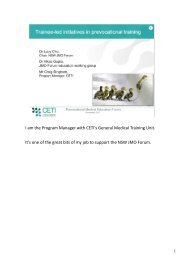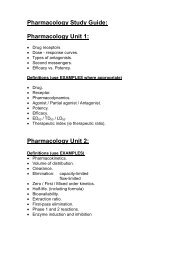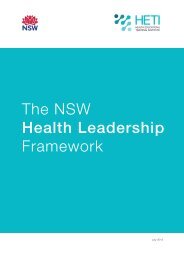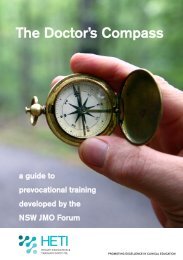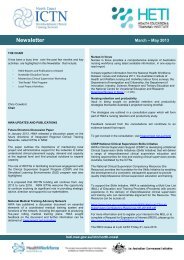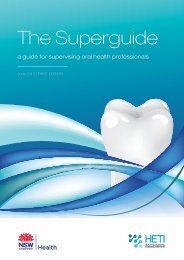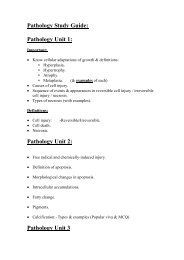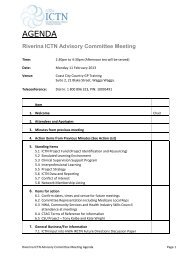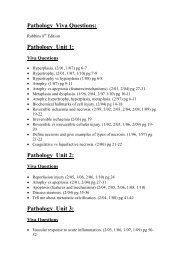a handbook for supervising allied health professionals - HETI - NSW ...
a handbook for supervising allied health professionals - HETI - NSW ...
a handbook for supervising allied health professionals - HETI - NSW ...
Create successful ePaper yourself
Turn your PDF publications into a flip-book with our unique Google optimized e-Paper software.
Orientation is the key to effectively introducing a new staff member into the clinical area<br />
or facility and setting the supervisory relationship. Supervisors are often responsible <strong>for</strong><br />
organising or participating in orientation <strong>for</strong> new staff members, even if they delegate parts<br />
of the orientation to other staff. Multidisciplinary orientation should be considered where<br />
possible as it immediately begins to meld the staff member into the clinical team.<br />
Allied <strong>health</strong> <strong>professionals</strong> highly value a <strong>for</strong>mal orientation. Not orienting a staff member<br />
sends some strong negative messages about the professionalism of the team they are<br />
joining. Lack of orientation is often a root cause of later problems that staff members may<br />
experience as they settle into their new role.<br />
It is useful to have a checklist to ensure that orientation is comprehensive (see below).<br />
Wherever possible, include a face-to-face handover to a new staff member. A succinct<br />
(written or digital) orientation package is an excellent welcome gift. Such packages<br />
need regular updating.<br />
Orientation provides the supervisor with the opportunity to review the staff member’s<br />
current level of knowledge and experience and to develop a plan to meet their particular<br />
learning goals.<br />
Benefits of a successful orientation extend to the whole clinical unit. With a<br />
multidisciplinary, interprofessional collaborative practice approach, teamwork and<br />
collaborative relationships are promoted and staff can be better supported. In addition,<br />
clinical care of patients will benefit from the use of standard procedures and protocols<br />
by all members of the team.<br />
Checklist <strong>for</strong> orientation:<br />
Orientation should include:<br />
the major focus and goals of the clinical team and the expectations of the clinician’s role<br />
roles and responsibilities of the clinician and other members of the department<br />
three month review (or as per organisational requirements)<br />
expected daily tasks<br />
hints <strong>for</strong> successful interactions with other staff members (who is on the team –<br />
key team members and their roles)<br />
procedures <strong>for</strong> making referrals to internal and external service providers<br />
other administrative procedures, including documentation<br />
supervision needs<br />
learning objectives and skills training goals<br />
in<strong>for</strong>mation about professional development opportunities<br />
general in<strong>for</strong>mation about work practices, protocols and guidelines as they apply<br />
key principles of clinical handover (<strong>NSW</strong> Department of Health 2009a)<br />
the process of annual <strong>for</strong>mal review.<br />
SECOND EDITION<br />
Orientation<br />
<strong>HETI</strong><br />
THE SUPERGUIDE<br />
63



